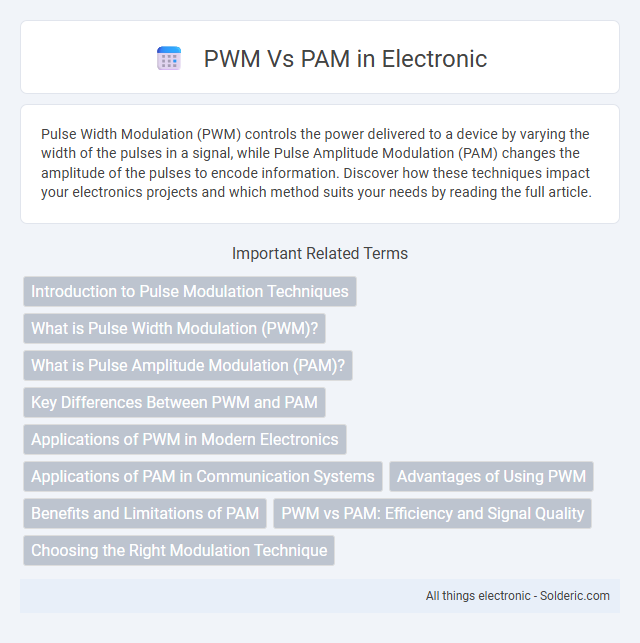Pulse Width Modulation (PWM) controls the power delivered to a device by varying the width of the pulses in a signal, while Pulse Amplitude Modulation (PAM) changes the amplitude of the pulses to encode information. Discover how these techniques impact your electronics projects and which method suits your needs by reading the full article.
Comparison Table
| Feature | PWM (Pulse Width Modulation) | PAM (Pulse Amplitude Modulation) |
|---|---|---|
| Definition | Modulation by varying pulse width | Modulation by varying pulse amplitude |
| Signal Parameter Controlled | Pulse duration (width) | Pulse amplitude (height) |
| Common Applications | Motor control, LED dimming, power delivery | Analog signal transmission, optical communication |
| Signal Robustness | Less affected by amplitude noise | More sensitive to amplitude noise |
| Complexity | Moderate encoding and decoding circuits | Simple encoding and decoding circuits |
| Bandwidth Efficiency | Lower bandwidth usage | Higher bandwidth usage |
| Power Efficiency | High power efficiency | Lower power efficiency |
Introduction to Pulse Modulation Techniques
Pulse Width Modulation (PWM) and Pulse Amplitude Modulation (PAM) are fundamental pulse modulation techniques used to encode information in digital communication systems. PWM varies the duration of each pulse, while PAM changes the pulse's amplitude to represent the signal's value, making each method suitable for different applications such as motor control (PWM) and analog signal transmission (PAM). Understanding your system's requirements helps determine the appropriate modulation technique for efficient data encoding and transmission.
What is Pulse Width Modulation (PWM)?
Pulse Width Modulation (PWM) is a technique used to encode information by varying the width of pulses in a signal while keeping the frequency constant. PWM efficiently controls power delivery to devices such as motors, LEDs, and communication systems by adjusting the percentage of time the signal remains high within each cycle, known as the duty cycle. Your ability to regulate output voltage or power using PWM makes it essential in applications requiring precise control and energy efficiency.
What is Pulse Amplitude Modulation (PAM)?
Pulse Amplitude Modulation (PAM) is a technique where the amplitude of each pulse in a signal is varied to correspond to the sample value of the original analog signal. Unlike Pulse Width Modulation (PWM), which manipulates pulse duration, PAM directly encodes information through changes in pulse height, making it suitable for digital communication systems. Understanding PAM helps you optimize signal processing in applications like audio transmission and data communication where amplitude variation carries critical information.
Key Differences Between PWM and PAM
Pulse Width Modulation (PWM) varies the width of each pulse to encode signal information, while Pulse Amplitude Modulation (PAM) changes the amplitude of pulses. PWM is commonly used in motor control and power delivery due to its efficiency in managing energy transfer, whereas PAM is integral to digital communication systems for transmitting data through amplitude changes. The fundamental distinction lies in PWM maintaining constant pulse amplitude with variable duration, contrasting with PAM's fixed pulse duration and variable amplitude.
Applications of PWM in Modern Electronics
Pulse Width Modulation (PWM) is extensively used in motor control systems, enabling precise speed and torque regulation in electric vehicles, drones, and robotics. PWM also plays a critical role in power electronics for efficient voltage regulation in DC-DC converters and switching power supplies. Additionally, PWM is utilized in audio signal processing to improve sound quality and reduce distortion in amplifiers and audio synthesizers.
Applications of PAM in Communication Systems
Pulse Amplitude Modulation (PAM) is widely used in communication systems for transmitting data over baseband channels such as Ethernet and digital subscriber lines (DSL). It enables efficient digital signal representation by modulating the amplitude of pulse signals, making it suitable for high-speed data transmission and multiplexing. PAM is also integral to optical communication in fiber optic networks, where it supports high-bandwidth data transfer with minimal signal distortion.
Advantages of Using PWM
Pulse Width Modulation (PWM) offers precise control of power delivery by adjusting the duty cycle of pulses, resulting in higher efficiency and reduced heat dissipation compared to Pulse Amplitude Modulation (PAM). PWM's robustness against noise and signal degradation makes it ideal for motor control, LED dimming, and communication systems. You benefit from enhanced accuracy and energy savings when using PWM in various electronic applications.
Benefits and Limitations of PAM
Pulse Amplitude Modulation (PAM) offers the benefit of simpler implementation and efficient bandwidth usage compared to Pulse Width Modulation (PWM), making it suitable for high-speed digital communication systems. However, PAM is more susceptible to noise and signal distortion, which can degrade signal quality and limit transmission distance. Your choice between PWM and PAM should consider these trade-offs depending on the application's sensitivity to noise and bandwidth requirements.
PWM vs PAM: Efficiency and Signal Quality
PWM (Pulse Width Modulation) offers higher efficiency by controlling power delivery through varying pulse durations, reducing energy loss in devices like motors and LEDs. PAM (Pulse Amplitude Modulation) varies signal amplitude, which can provide simpler implementation but often suffers from lower noise immunity and signal distortion in noisy environments. Your choice between PWM and PAM impacts overall signal quality and energy efficiency depending on the specific application requirements.
Choosing the Right Modulation Technique
Choosing the right modulation technique depends on your specific application requirements such as signal quality, bandwidth efficiency, and power consumption. Pulse Width Modulation (PWM) offers precise control of power delivery and is ideal for motor control and power supplies, while Pulse Amplitude Modulation (PAM) provides simpler implementation and higher data rates suited for communication systems. Understanding the trade-offs between PWM's timing precision and PAM's amplitude variation helps optimize performance in electronics and signal processing.
PWM vs PAM Infographic

 solderic.com
solderic.com